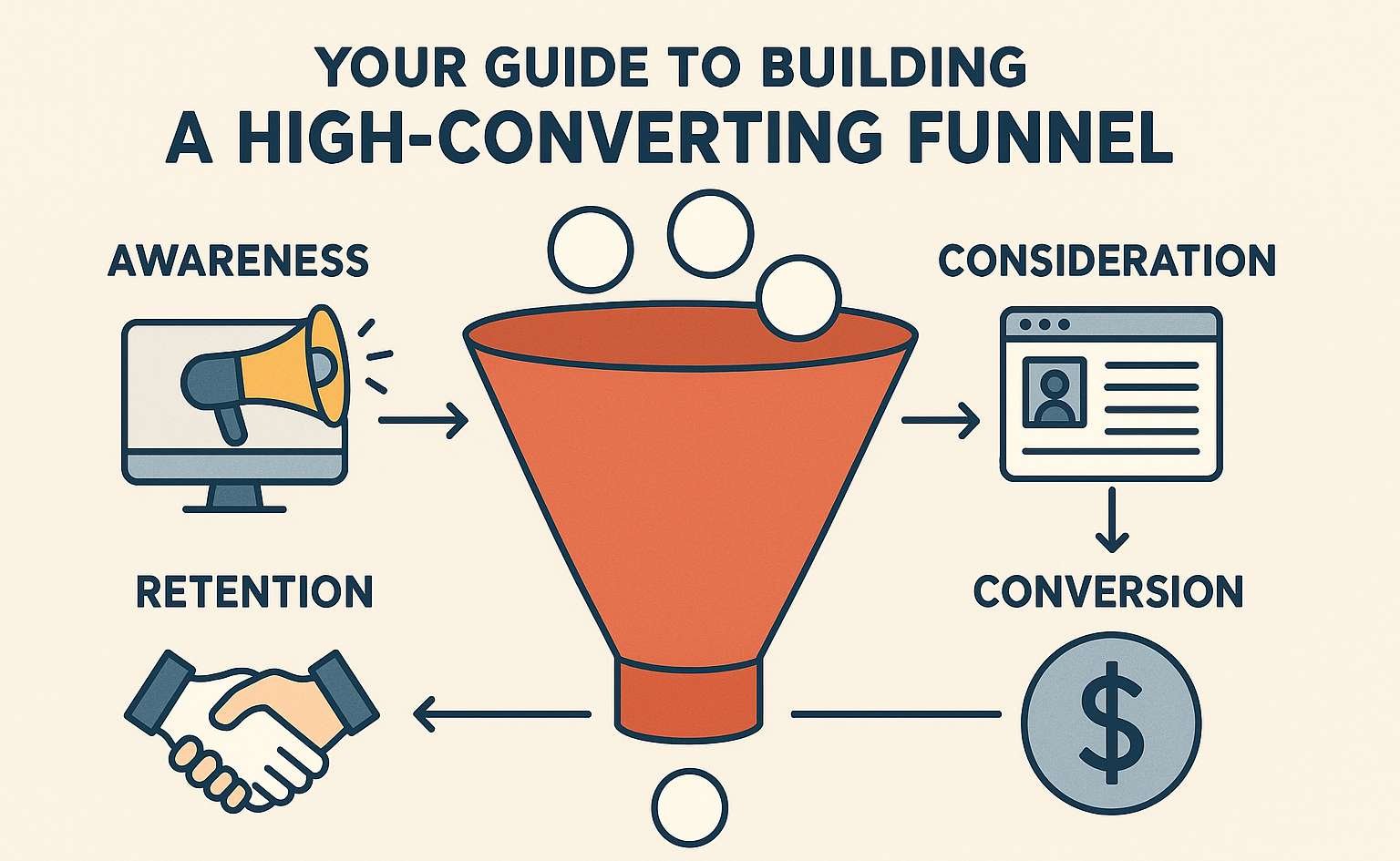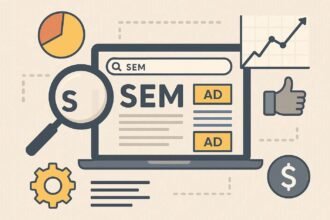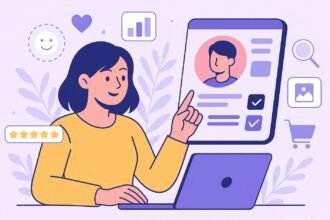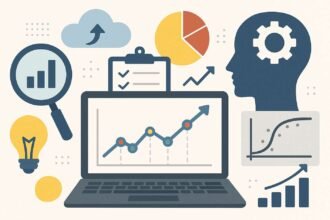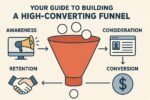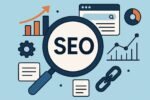Introduction to Conversion Funnels
Every business needs a path to grow its customer list or basis and earn consistent revenue without excessive anxiety or unsustainable risk. A conversion-focused funnel is a sequence of steps, actions, and engagement touches to move buyers along that path—from initial awareness through consideration, conversion, retention, and advocacy. An effective funnel is built around the behavior and psychology of the target buyer journey, using compelling hooks to initiate engagement and nutrured with meaningful interactions that preempt questions, resolve objections, and create urgency all the way down to the point of conversion.
The process also involves choosing the right set of high-value offers and marketing resources at every stage to maximize lifetime value per customer, whether by increasing early-stage conversion rates or optimally sequencing offers with the highest sales potential for an existing audience. Conversion-first funnel planning is an outcome-focused marketing activity that synthesize insights from across the entire business, so every section on this site impacts the funnel design—in particular, the sections on Research and Audience Understanding, Funnel Stages: Awareness to Advocacy, and Channel Strategy and Traffic Acquisition. Later sections on Content and Communication Strategy, Lead Nurturing and Automation, and Analytics, Measurement, and Optimization are also framed around the conversion-first funnel process.
What is a sales/conversion funnel?
Sales or conversion funnels are the paths that prospective customers take from first hearing about your product or service until they actually buy, and often beyond. They provide a framework for understanding prospective customers’ needs at various stages and, correspondingly, the best way to guide them toward a purchase. Sales funnels are also a model for establishing measurable business goals as well as a marketing framework for building cause-and-effect relationships. Finally, they can serve as an important linking mechanism: Expanding the funnel requires new visitors; decreasing costs per acquisition requires new customers; increasing conversion rates requires effective lead nurturing; improving churn rates raises the amount of money customers spend.
There are many common funnel types, including those optimized primarily for lead generation, product-led sales, webinars, and freemium offers. Each is designed to maximize the lifetime value of the users it attracts by optimizing a specific market entry path. Funnel design also covers sequencing: the order in which the monetization steps are presented and themed, along with the levels at which they’re priced.
Key metrics and stages
The traffic funnel visualizes how users flow through the marketing and sales processes, helping teams see how many people drop off at each step. As with any visualization, it will only be accurate and useful if teams use it consistently. Clearly defined funnels also enable the measurement of key metrics for each stage and support the identification of underlying assumptions that should be validated.
Marketing and sales funnels typically have five core stages: awareness, consideration, conversion, retention, and advocacy. Marketers will track awareness metrics such as impressions, reach, and traffic to capture the initial reach of marketing efforts. Consideration metrics such as click-through rates and form leads will measure user interest and intent. Conversions, the act of purchasing, generate revenue for companies that track revenue, cost-per-order, or margin-per-order for at least some aspects of their equipment. Tracking return customers and repeat orders will support retention insights, and monitoring social media mentions and reviews will capture advocacy.
Common funnel archetypes
Often, funnels in their simplest form are designed as lead generation. These funnel types offer something useful to the audience in exchange for contact details—such as a copy of the company’s research report, a free demo of a product, or a free consultation session—and, crucially, continue sales conversations.
Another common funnel type is product-led, where a software company offers a freemium version of a software application or some similar product. Users have access to a limited but useful version of the product and can upgrade to the paid version (having proven willingness to pay) as their needs grow.
A third common funnel archetype does not try to directly monetize offers. It provides valuable free content across many channels, building relationships and establishing credibility in the market. The most widely used type of content in such funnels is webinars, with participants invited to buy something at the end.
A fourth fairly common funnel type is a freemium model in which a game or a similar community product is released for free, with growth coming from word-of-mouth rather than advertising, and monetization routes focused on selling content/additional features to the community.
Research and Audience Understanding
Audience understanding informs the design of every funnel component. A thorough grasp of the audience, their desires and needs, their motivations, and their likely objections sets the foundation, guiding the creation of compelling messages in tempting offers and supporting content throughout the entire funnel.
Much of that foundational research needs to be consolidated into a concise set of clear buyer personas, addressing the needs, motivations, and objections of the primary core segments driving demand for a business’s products or services. In this stage of the funnel, the central focus is not the offer itself but the audience or audience segments driving demand. Why would your ideal customers not only react to your marketing outreach but engage positively? What signals will they respond to, and how can these signals be mapped to actions during the customer journey? This analysis is fundamentally strategic in nature and is best captured, documented, and consolidated in search of clear, compelling, and competitive value propositions.
Target audience and buyer personas
Audience research translates into buyer personas that provide detailed profiles of the target audience and help address their pain points, identify why they would be interested in your product or service, and recognize what might stop them from taking your desired action.
Buyer personas typically define four facets that most concern you:
1. Objectives. What outcomes are they hoping to achieve? Are they looking for a way to be healthier? Are they pursuing professional advancement? Are they working to keep costs in check? What is their main goal?
2. Triggers. What events propel a potential target into pursuing these objectives? Does an opportunity, such as a job opening, push them toward a new resume? Does the arrival of summer motivate a desire to lose weight? Or perhaps an injury drives a pain-free activity? A target persona should identify the internal and external factors that steer customers into your funnel.
3. Needs. What capabilities would people ideally like to have for a solution? Do they want to know a product works? Do they want to be assured of success? Are they looking for the best price, or should the service just feel right? Identifying these requirements lets you tailor your messaging to address targets’ needs and help them see that your value proposition checks the right boxes.
4. Objections. In what ways might potential targets argue against making a purchase? What evidence might convince them otherwise? Are there competitive solutions that typically win? A detailed analysis of these obstacles helps to proactively dismantle them and head off arguments or extensions during the sales process.
Value proposition and messaging
The value proposition articulates the compelling reasons why a target customer would choose to buy a product or service from a specific organization instead of a competitor. It states the tangible benefit that the buyer will receive from the product or service and the unique attributes that differentiate it from offerings from competitive vendors. Market forces will help to shape the business model by identifying the factors that the target audience seeks in its vendor relationships, as well as the strengths that the organization can leverage to position itself competitively in the marketplace and meet audience needs through every stage of the funnel.
The output should also provide an implementation-ready message hierarchy that contributes to the subsequent development of persuasive writing that converts awareness into interested consideration, consideration into intent to buy, and consent to buy into advocacy.
Competitive analysis and market signals
Positioning a conversion-focused funnel depends on a broad understanding of how the offering compares to alternatives for the target audience. Signals that indicate whether a funnel is succeeding or stagnating include: What do competitors offer? How is the company perceived relative to the competition? What success stories—actual customers achieved real success with the offering—are being communicated? What brand signals are being communicated with funnel elements such as price, website design, and advertising tone? How are other companies in the space allocating marketing resources?
Answering these questions creates a set of benchmarks against which the funnel’s progress can be measured, and outlines the signals that should be closely monitored to detect churn risk and funnel bottlenecks, or to identify new, high-impact, content marketing opportunities. Signals are connected to channels in order to optimize the marketing plan—funnel designers know what steps to take if, for example, monitoring highlights an absence of marketing communications seen as authoritative by the target audience.
Funnel Design and Architecture
The funnel architecture lays the foundation for funnel execution. It outlines the funnel’s structural elements: stages, their entry points, and how people flow from one stage to another. The design must align with the customer journey map, which identifies visitor touchpoints, moments of truth, and transfers between teams.
The transformation of web traffic into customers follows a funnel shape because visitors drop at each stage. Different audiences and offers define the entry points. The visit may end or it can continue through a predefined flow that fosters conversion from one stage to the next.
Mapping the customer journey
Touchpoints across various marketing channels form the customer journey to facilitate the conversion process. Identifying critical moments of truth enables the creation of an empathetic approach to address needs, alleviate concerns, and build trust. Mapping these points also highlights handoffs or conversations between the marketing and sales functions to ensure frictionless transitions.
Every channel in the marketing mix plays a part in bridging the customer journey. Lead magnets, high-value offers that initiate the first contact with potential customers, allow for entry into the funnel. Content—written articles, videos, images, and advertisements—encourages movement from awareness to purchase. Emails sequence follow-up information according to an individual’s point in the customer journey or previous digital interactions. Social media fills the gaps between all other channels while comments present opportunities to clarify confusion, make a sale, or strengthen the relationship.
Funnel stages: awareness to advocacy
Funnel stages define the goals, metrics, and content for each phase of the funnel, encompassing the metrics established in Key metrics and stages as well as resource requirements from Content and communication strategy. Describing the continuity within the above resources, the material addresses each stage of the funnel in turn.
Awareness is the stage where prospects first discover your brand, product or offer. Content should address high-level themes that are relevant to your audience; written resources like blog posts, social updates and interviews are commonly effective at this point. The primary goal is simply to drive traffic, with sessions and new visitors between devices serving as the essential metrics. At this stage of the funnel, leads have not yet expressed interest in your brand, so traditional promotional CTAs risk coming off as spammy; instead, YOY growth in branded keyword searches signals that content is resonating with the target audience. The next phase of the funnel, consideration, is where prospects start to see your brand as a solution to a specific problem or need.
Lead magnets and entry points
High-value offers act as magnets, facilitating entry into the funnel, with an expanded rundown in the Content for each funnel stage section.
Magnets may include:<ul><li>free consultations</li><li>sample products</li><li>free trials</li><li>discounts</li><li>cheat sheets</li><li>ebooks</li><li>white papers</li><li>reports</li><li>checklists</li><li>tools</li><li>webinars</li><li>live events</li></ul>High-impact, low-friction offers act as magnets guiding prospects into the funnel, with detailed descriptions in Content for each funnel stage.
Offer sequencing and pricing ladder
A pricing ladder offers a clearly defined path that buyers can take through a selection of products and services. It assigns product dependencies or bundling sequences such that buyers are guided through the purchase journey without unnecessary friction. The aim is to maximise customer lifetime value through effective offer sequencing.
A pricing ladder integrates revenue generation into the buyer’s customer journey by enabling buyers to readily identify that additional products or services are needed or wanted. Clear entry points, such as lead magnets, free trials, and freemium products, help in acquiring customers. And a clear pricing ladder — combined with nurturing — maximises the chance that additional products or services will be purchased or consumed. Consideration of price-willingness and budget, combined with the minimisation of risk, helps to avoid perceived ‘over-stretching’ a buyer by offering additional products with a natural dependency at appropriate moments.
Content and Communication Strategy
Strategic alignment of content and communication across all funnels drives consistent storytelling and effective message delivery. Banners, display ads, social content, white papers, sales scripts, email, and landing pages should all speak the same language. In-depth writing guides established in the Writing that converts section inform execution, defining brand voice and delineating high-impact hooks and persuasive rules applying to all forms of content.
Specific content types are mapped to each funnel stage in the Content for each funnel stage section. A separate emphasis on CTAs ensures offers are clear and unambiguous throughout the customer’s journey, reinforcing the individuality and intent of each content piece while moving toward funnel completion. Message structure, persuasive copy, and strong calls to action guide the potential customer in every interaction, facilitated by visuals, design, and user experience that reinforce the message without distracting attention.
Content for each funnel stage
Strategic planning for content types, depth, and storytelling aligns engagement with amplification at each stage of the funnel. Content marketing succeeds through a careful blend of entertainment, inspiration, or direct response for audience engagement, coupled with distinctive storytelling, authority, relevance, or humor for social sharing. Content in each stage of the sales funnel should possess the necessary properties for engagement within the given context.
Awareness: At the awareness stage, content should be introductory and high-level. Potential customers are unaware of the full range of solutions available to them, let alone which solution is best for their needs. Content can take forms such as opinion pieces, broad industry commentary, white papers, reports, and infographics.
Consideration: At the consideration stage, content may provide greater depth into particular areas of interest, analyzing specific market segments or delving deeper into high-level topics. It is essential for consideration stage content to individually appeal to buyers in the various segments. Form examples include in-depth articles, case studies, industry analyses, eBooks, and webinars.
Conversion: At the conversion stage, content should offer answers to specific, short-list questions as buyers seek to confirm a preferred option. Potential customers may even value negative justification as much as positive, scrubbing a shorter list for sub-standard options. Content forms can include product comparisons, reviews, testimonials, demos, and trials.
Retention: Once a purchase decision has been made, customers become keenly interested in maximizing the value derived from that decision. Information to guide and enhance product usage often proves essential. Depth of product usage also presents variations in content demand; while large- and single-user product buyers may use a product for its core purposes, companies with many advertisers, designers, or developers often demand content tailored to a range of specialist users.
Writing that converts and CTAs
Copywriting principles, persuasive hooks, and direct calls to action must all align to create clear, motivating, and engaging traffic and conversion copy.
Developing a toolbox of hooks, templates, and techniques for writing that converts is immensely valuable; many great writers have distilled concepts into simple checklists. Describing the customer’s world before introducing a benefit that speaks directly to their needs and desires continues to be a powerful approach, regardless of medium.
At every step of the conversion sequence, the prospect’s natural objections and doubts should be addressed before asking them to commit—whether to read further, provide an email address, or make a purchase. When converting traffic, writing should be simple, direct, and visually scannable, so the reader instinctively grasps key points at a glance, even if they don’t read every word. Finally, every action should be accompanied by a clear CTA that states exactly what the prospect should do next.
Visuals, design, and UX considerations
Making the decision to commit an actionable investment—for a service, for a product, or for any other alternative that might cost money or time—is a significant milestone on the customer’s journey. The path to this decision is fraught with uncertainty and anxiety. Concerns must be put to rest and questions answered.
An experience that is a pleasure to navigate—visually appealing, easy to comprehend, and in line with how the user expects to find and interact with the material—is now not just a bonus, but an imperative. The website or landing page of someone making a sales pitch must follow the same rules of interface, user experience (UX), and accessibility experientially that a high-quality brochure must follow visually. The brand voice must echo in rhythm and tonality through the web, blog, and emails. The basic principles are well known. The important decision here is not whether to apply them, but how to apply them to best serve the purpose for which the funnel has been created and drive conversion in that context.
Visuals supporting a funnel at any stage should showcase the benefit as the viewer would envision it, fit the messaging of the funnel seamlessly, capture the viewer’s attention immediately, and enhance the overall brand experience. They can convert the viewer from a curious visitor into a confident purchaser, initiate a valid conversation between the reader and the marketer, or enhance the perceived value and authenticity of the entire pitch at any level. Well-chosen graphics that resonate with quality and reflect the sophistication of the business go a long way in elevating credibility and trust.
Channel Strategy and Traffic Acquisition
An effective funnel will map content and communication strategies to both paid and organic channels. Growth through paid channels can often be rapid. It can also be risky. A strong channel strategy creates a foundation that makes growth through paid channels sustainable for the least amount of investment. Without a plan, and without supporting organic programs, paid channels can become a churn-and-burn “land grab,” diverting focus from creating an amazing product that truly satisfies users and fulfilling service-level agreements. Growth through organic channels takes time, investment, and willingness to go slow. Not providing enough of a value to users or businesses for organic channels to deliver a strong return on investment across the entire customer lifecycle creates risk and waste. By allocating budget appropriately across channels during pour phases and investment during growth phases, long-term goals are still achieved without risk.
Organic channels vs paid channels
Both organic and paid traffic channels should be considered when investing in the conversion-focused funnel.
Pay-per-click advertising delivers traffic immediately. It allows for quick testing of messaging and offers, and advertising channels include Google Ads Advertising, Bing Ads, Facebook Ads, Instagram Ads, LinkedIn Ads, YouTube Ads, Twitter Ads, and other sites and platforms that offer advertising. However, because these channels are paid, in the long term, they can be very costly. If, in addition, the objectives are incorrectly defined, the risk is to invest a lot of money in ads that are not converting, or that convert very little. It is important to analyze the attribution model that allows you to evaluate all conversions over time and to define investments and methods of monitoring costs with moderation.
In the long term, organic channels that provide quality content allow reducing the cost of conversion and generating reliable traffic that, even if it were paid, would represent a much lower cost than paid advertising. Organic traffic channels for the conversion funnel include Google organic search, YouTube organic search, Tik Tok organic search, other social channels that can generate organic traffic, and affiliates.
Social, email, search, and partnerships
Each of the traffic channels previously explored offers unique audiences and advantages. They can also be used to optimize the overall performance of your funnels and marketing programs. For every channel, dedicated messaging, graphics, and offers should be created to account for the different stages of the customer journey, from the initial awareness to consideration to final purchase.
The following list includes the channel strategy and specific channels that can be leveraged, plus recommendations on integrating the email, social, and search engines channels around the customer journey:
• **Social** – Use social media platforms to attract, educate, and motivate audiences to convert. At every point in the path, from awareness to consideration to conversion, you should be presenting different content offerings on social. Think about the content your ideal target would find useful or valuable when they are looking, whether that is through Facebook, Twitter, LinkedIn, or TikTok or whatever social platform they are in.
• **Email** – Email is still the best way to engage and convert your leads and prospects. Save your sales messages for the email channel, as direct approaches often don’t convert well on social or search. Instead, provide valuable insights that build your credibility and trust. Keep your voice supportive and constructive. Present your solutions in the context of your conversations and the triggers you are addressing.
• **Search** – Many times, prospects are conducting searches and looking for solutions relevant to their needs. Make sure you have the search engine ads and links aligned with the appropriate conversions. You will want to make sure that the content on the landing page fulfills the promise of your paid ad—to help them solve their pain. Don’t just promote your product or solution. Provide value to your visitors. Guide them toward action.
• **Partnerships** – Tap into the audiences of other companies that have solutions or products complementary to yours. Seek to develop partnerships or referral programs that allow you to access their audience for new leads. From webinars to presentations to educational articles, there are many ways to leverage others’ connections.
Budget allocation and attribution
Budget allocation represents the “how much” element of traffic acquisition, addressing the allocation of spend against a variety of channels used to drive traffic into the conversion funnel. In an ideal world traffic acquisition spend would be directly correlated with the value it generates. Unfortunately, this ideal is rarely achieved due to the inherent challenges of associating actual revenue generated with a given acquisition channel, particularly when multiple channels have operated over time and the impact of branding is usually undocumented. Basic principles of attribution modeling and the establishment of a historical database of channel performance are typically all that is needed to establish credible models for the allocation of budget across channels, both for organic and paid traffic streams, which will change the way they are viewed.
The principles of attribution modeling have been well covered in a number of marketing texts and can be summarized briefly here for completeness. Attribution modeling is simply a method of assessing the contributions made by different marketing channels toward actual revenue generation. In any demand generation endeavor the customer typically interacts with multiple channels before making the decision to purchase. For example, he/she may see a display advertisement for a product, later receive a direct mail piece from the company, then see an advertisement in the newspaper, look for the product on Google, then finally complete the purchase by clicking through on a paid advertisement on Google. Each of those interactions contributed at some level to closing the sale, but how does one assign credit for the sale?
There are a number of approaches to attribution modeling; the simplest models give all the credit to the final channel through which revenue is generated, or perhaps assign the revenue equally across all the channels used prior to purchase. More advanced models are based on proportional allocation (i.e., model A) or on assumptions regarding the level of influence different channels exert (models B-F). The choice of model depends on the type of business in question, the channels being considered, the available data, and other factors. The important point is that the chosen model should be applied consistently across all budget allocation decisions. Consequently, the model is set once and only updated over time according to rigorous change control procedures.
Lead Nurturing and Automation
Lead nurturing leverages drip sequences and automated rules based on user behavior. Cold leads receive pre-built sequences to encourage engagement and conversion, while internal databases get lifecycle messaging aligned with their currently relevant needs. Beyond engagement, behavioral rules trigger upsells, resells, and retention messaging using customer data.
Email drip campaigns and lifecycle marketing feature sequences designed for each customer journey stage—with conversion, upsell, and retention themes. Campaign design accounts for all funnel phases: cold leads receive sequences aimed at conversion, while customers get resell and retention messaging appropriate to their positions in the journey. Campaigns are integrated with the CRM to ensure all data is up to date and that customer interactions support subsequent email stream behavior.
Email drip campaigns and lifecycle marketing
Lifecycle-based email marketing maximizes response by sending the right message at the right time. The overall drip strategy maps to the funnel stages, addressing the particular needs and concerns of users when they’re in the consideration phase or during the onboarding process, and leading into retention and upsell- or cross-sell-oriented messages. Further detail is included in Writing that converts and CTAs, which define guidelines for crafting the messages, and in Content for each funnel stage, which identifies topics and content types for the writing.
For users who have opted in to the email list but are not yet customers, the messages might include a welcome email, followed by low-friction offers (such as free trials or clear lead magnets) and persuasive content that helps guide their decision-making. For those who have purchased but are still early in the customer journey, the focus should be on helping them realize value and guiding them along the onboarding process. Triggering email messages on behaviors such as visiting the pricing page or engagement with key content can spark an upsell/cross-sell conversation. Finally, for longer sales cycles, consider a more automated engagement with periodic value-added content.
Behavioral triggers and personalization
Behavioral triggers, personalized content, and messaging enhance conversion. Triggered messages—including behavioral, lifecycle, and cart abandonment emails—ensure relevance, context, and timeliness. Dynamic content in emails and landing pages, based on behavioral history, preferences, and location, boosts effectiveness. For accounts, adhering to privacy policies and norms is critical; for anonymous users, policymakers should pattern behavior, motivating carefully and explicitly transitioning between identification and personalization.
Triggering content and messages based on user behavior through a CRM or marketing automation platform enhances relevance and conversion. Because personal data is sensitive, dynamic content should add value rather than supplant trusted content; e.g., different recipes for vegans or gluten-free customers, not different ads for a plastic surgery clinic—in those cases, personal stories tend to resonate (positively or negatively). In the case of non-accounts, individuals should be prompted to identify themselves before receiving highly personalized offers.
CRM integration and data hygiene
Funnel effectiveness hinges on high-quality audience engagement, requiring precise evaluation of channel health, conversion trends, lead nurturing needs, and data privacy compliance. The integrity of all funnel-driven initiatives depends on reliable data in the Customer Relationship Management (CRM) system; key areas of concern are segmentation for targeted messaging, data hygiene for clean and complete records, and privacy compliance for responsible handling of personally identifiable information (PII).
Integration with marketing automation systems ensures pertinent lead properties are transferred into the CRM for appropriate communication. Both teams should also establish data hygiene procedures: marketing contacts must possess mandatory fields so they can be contacted or, at minimum, recognized if they engage with sales. Additionally, ongoing data maintenance is crucial, whether achieved through algorithms, user-driven updates, or outsourcing. Formal data privacy policies must express attribution models, consent options, opt-in management, and processes to handle requests for profile viewing and deletion, reflecting a commitment to protecting customer privacy.
Conversion Optimization Techniques
Successful conversion-focused funnels leverage a continual cycle of testing and optimization across all stages and touchpoints. Simple A/B testing of different page variants has become a widespread practice, and properly managed can yield reliable and valuable insights. When placed within a more structured testing and conversion optimization framework, this practice can drive even greater return-on-investment.
At a fundamental level, optimization techniques are undertaken to solve identified problems or test proposed improvements against objective criteria. Nonetheless, an initial testing framework that documents multiple changes and their objectives will simplify future testing, sustain repeatable success, and help convert insights into best practices.
A/B testing and multivariate testing
A-B testing and multivariate testing are two fundamental techniques for quantifying the impact of changes made to a landing page and for determining the most effective design out of multiple alternatives. Each technique typically consists of three phases:
Design phase: Determine what aspect of the page might be improved, develop hypotheses for a design that would achieve the desired improvements, and select alternative designs for analysis. Analysis phase: Monitor engagement and conversion metrics while exposing actual users to the alternative designs under controlled conditions. Decision phase: Evaluate performance relative to the experiments’ success criteria and use the results to inform future design decisions. The depth of analytics depends on the complexity of the test. For example, A-B testing might remain relatively high-level if there are only a few confirmatory changes involved, in which case hypothesis-driven testing might suffice. In contrast, a multivariate analysis of a new landing page might yield a much deeper and wider set of recommendations.
Landing page best practices
Landing pages convert visitors into prospects or customers. They offer a clear explanation of the value of responding to your call-to-action. To meet consumer expectations, landing pages must be focused and provide easy-to-scan information supporting a single desired action. Choose from a single-product display page, a lead capture page, or an advertising campaign landing page.
Whatever the design, every landing page must include:
• a clear description of the product’s features and benefits, • evidence of promises kept (e.g., testimonials, case studies, product reviews), • credibility (e.g., awards, appearances in prominent media, partnerships with respected vendors), • reassurance (e.g., product warranties, money-back guarantees, privacy policies), and • quick load speed.
Form optimization and friction reduction
Contact forms are often the vehicle through which hard-earned traffic converts into leads. Yet in many cases, they are hastily conceived and carelessly executed. Consider the following checking points to increase the odds of page visitors completing an online lead generation form. **Minimize the number of fields.** Keep forms short and simple, asking for information needed in the immediate term. For a free trial, anything beyond the email address and some product-usage-related information is often excessive. For a white paper or some other high-value offer, first name, last name, and email address are usually sufficient. If additional fields appear necessary, consider using progressive disclosure, in which these fields are added over time. A user who had been through several transactions may then be comfortable providing more information. **Consider progressive disclosure.** Rather than asking a visitor to complete a lengthy form just to gain access to a trivial piece of information, offer a simple entry point with only an email address (perhaps via a pop-up) and then slowly engage the user through a triggered drip sequence. Questions and fields asking for personal information can be added along the way with each offer that carries more value. Returning visitors can be recognized via cookies, so it is possible to ask for more with comfort. It’s advisable to have the tracked clicks fire a cookie and start the campaign just as soon as the email address is collected, if not sooner. **Focus on scent.** The language, style, and tone used in the form fields and their labels should mirror that of the advertisement that brought the user there in the first place. Keep in mind that it is common for users to scan forms quickly, so plain English with appropriate humor works well. It is advisable to be clear and transparent about what is being requested and why.
Analytics, Measurement, and Optimization
Defining a conversion-focused funnel and effectively communicating funnel health, drop-offs, and growth opportunities typically require the joint effort of several professionals. A conversion-focused funnel is a logical sequence of steps that leads to a desired action—a visit, a signup, or an actual sale in the context of digital marketing campaigns. The funnel concept provides a framework for developing a coherent strategy and a set of measurable requirements that, when validated by data and experimentation, can result in consistent success over time. As a result, a conversion-focused funnel can surface the critical steps of the marketing communications strategy, link those steps to business value, and provide a common language for support and operations teams.
Effectively structuring web analytics to measure funnel health, identify critical drop-offs, and surface growth opportunities is key for following the strategy’s execution, measuring budget and resource use efficiency, and identifying priority areas for ongoing optimization. Defining success metrics; funnel visualization and dashboards; cohort analysis and attribution modeling; compliance, ethics, and privacy; data privacy considerations; and compliance in marketing communications are the key components. Throughout these sections, the focus is on defining and implementing marketing success measures—not just in web analytics but also across the business.
Defining success metrics
Are all important metrics defined for every funnel stage? Use the call to action spreadsheet to drive the strategy for defining the metrics and KPIs. Key Performance Indicators (KPIs) are a way of quantifying progress towards achieving organization objectives by monitoring critical success factors. For each funnel stage, you need to identify what are the metrics that are critical for monitoring funnel efficiency and for decision making. These metrics can be directly related to OKRs outlined for readiness or can be stand-alone. Every goal set for a funnel stage needs to have a metric defined.
These KPIs are then fed into a reporting dashboard for checking and deeper analysis. Cohort analysis is essential to assessing the impact of funding weather and seasonality trends. Budget allocation and attribution discuss budget allocation across the funnel and the modeling of the attribution to various marketing channels.
Funnel visualization and dashboards
Strategies for visually communicating funnel health, drop-offs, and opportunities are critical for measurement and optimization. Key links include Cohort analysis and attribution modeling, which detail how to assign value over time and attribute to channels, and Core Education: Analytics, Measurement, and Optimization, which define success metrics, dashboards, and reporting cadence.
Visual amplication searches, scores, and cadence / Publication areas successful metric design for funnel success. Visual design must show overall funnel health, identify drop-off points, detect funnel errors, visualize abnormal behavior, and give an operational overview. Options for horizontal and vertical funnels should also be defined, with drop-off visualizations ideally placed above raw totals.
Cohort analysis and attribution modeling
A frame of reference is established when the funnel is arranged into four, tightly defined stages. For each funnel stage, vital analytics metrics—converted into objectives and key results (OKRs)—are established and integrated into a cohort-based analysis model. Such a model allows the allocation of all marketing expenditure to various channels based on a common attribution metric assigned on a last click basis. It ensures effective optimization of all channels.
The ability to assign value over time (Cohort analysis) and to give each marketing channel its share (Attribution modeling) combine to produce a powerful tool for measuring and optimizing the entire marketing mix. Such an analysis ensures that each channel is associated with a proportionate share of revenue and thus profit, allowing channel contribution and overall return on investment (ROI) to be constantly monitored, and decision-making to be concentrated on the areas generating the best results.
Compliance, Ethics, and Privacy
Consider how to use audience information responsibly, and how to ensure that audiences are entirely comfortable with their steps through the workings of the business. These two general perspectives can help define core protections and rules for consent. The business needs to ensure that data security is looked after, that privacy laws are followed, and that consent is guaranteed. The audience needs a clear understanding of how their data is managed and why, how its use will add value to their experience, how to remove permission at any time, and what to expect if they do.
Listing specific rules enforced whenever managing audience information is a good way to clarify privacy matters. For specific components of GDPR and other regulations, it is useful to consult a lawyer; the focus here is on areas that marketers intuitively should understand. A simple checklist is all that needs to be incorporated:
1. Consent for email marketing communications is required, and “soft” opt-ins should not be relied on 2. Unsubscribes and removals from lists are processed immediately 3. Audit trails for opt-ins and removals are created and retained 4. Custom-ease personal information (both official and inputted) is retained only for as long as is necessary to provide the services requested 5. Security processes for audience information are continually monitored and reviewed 6. The business will never sell or otherwise give away audience information 7. The business will not share audience information outside its own business groups without permission.
Data privacy considerations
The rising number of high-profile data breaches and subsequent regulatory intervention continue to convince individuals that they cannot trust marketers with their personal information. For marketers, this has resulted in a plethora of additional compliance requirements when running marketing communications, managing customer data, and indeed when collecting data in the first place. Companies that fail to protect users’ privacy or comply with these requirements risk damaging both their reputation and business.
Root protections, applicable to every company regardless of location, include: • Consent for all communications must be gathered at the point of data capture. • Customer and prospect data need to be cleaned regularly to remove duplicates and missing values, and to verify that individuals are still using their email addresses. • Opt-out requests of commercial email marketing must be honored. • Unsubscribes must be easy to complete and should not throw up barriers. • Information shared must be truthful, not misleading, and must accurately represent the content within the email.
Compliance in marketing communications
Policies around marketing communications should cover opt-ins, unsubscribe handling, and honest advertising across all media.
Email marketing is subject to specific regulations governing consent (opt-ins), content (accuracy and avoiding spam traps), and process (facilitating natural opt-outs). Marketing teams must have policies governing these issues in the context of the privacy laws governing their data jurisdiction (General Data Protection Regulation in the European Union, for example) but marketing departments also contribute. Legislation or internal guidance on statements made in advertising is also essential, as misrepresentation across any medium will hurt brand reputation and may expose the company to legal repercussions.
10. Conclusion
Funnel design and optimization encompasses six dimensions: research and understanding, funnel design and architecture, content and communication strategy, lead nurturing and automation, conversion optimization techniques, and analytics, measurement, and optimization. Establishing strong foundations with thorough content planning, empathetic communication, cohesive automation and nurturing, and a practical conversion optimization process support regular traffic and lead generation within defined budgets.
Research is fundamental to every other aspect of funnel design. Insight into the target audience and their preferences shapes the value proposition and messaging hierarchy, informs the choice of content types, determines the touchpoints and moments of truth to address, indicates which creative approaches and brand voice will resonate, and offers guidance on lifecycle messaging and automation rules. Research for funnel design overlaps considerably with analysis and segmentation of the target audience, complementary buyer personas, and competitive landscape.


